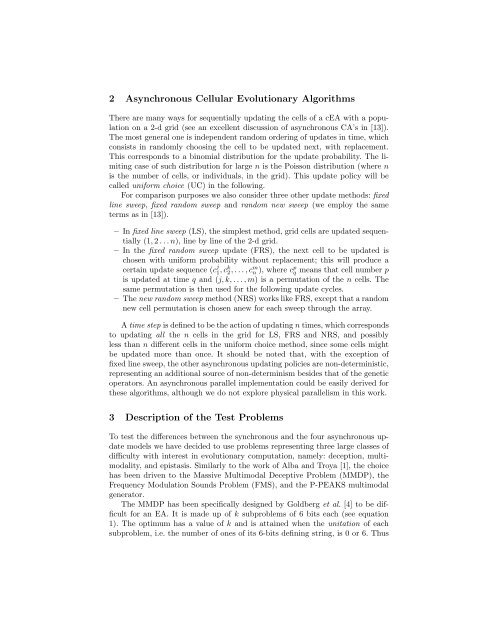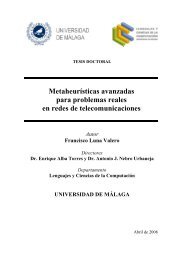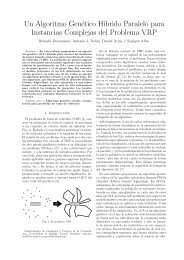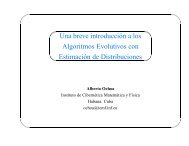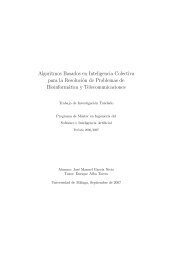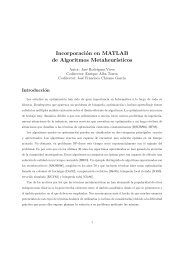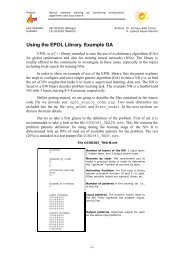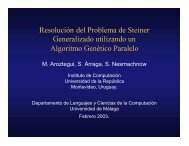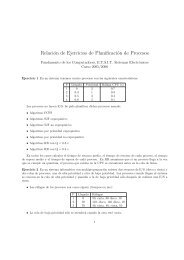Comparing Synchronous and Asynchronous Cellular Genetic ... - NEO
Comparing Synchronous and Asynchronous Cellular Genetic ... - NEO
Comparing Synchronous and Asynchronous Cellular Genetic ... - NEO
Create successful ePaper yourself
Turn your PDF publications into a flip-book with our unique Google optimized e-Paper software.
2 <strong>Asynchronous</strong> <strong>Cellular</strong> Evolutionary Algorithms<br />
There are many ways for sequentially updating the cells of a cEA with a population<br />
on a 2-d grid (see an excellent discussion of asynchronous CA’s in [13]).<br />
The most general one is independent r<strong>and</strong>om ordering of updates in time, which<br />
consists in r<strong>and</strong>omly choosing the cell to be updated next, with replacement.<br />
This corresponds to a binomial distribution for the update probability. The limiting<br />
case of such distribution for large n is the Poisson distribution (where n<br />
is the number of cells, or individuals, in the grid). This update policy will be<br />
called uniform choice (UC) in the following.<br />
For comparison purposes we also consider three other update methods: fixed<br />
line sweep, fixed r<strong>and</strong>om sweep <strong>and</strong> r<strong>and</strong>om new sweep (we employ the same<br />
terms as in [13]).<br />
– In fixed line sweep (LS), the simplest method, grid cells are updated sequentially<br />
(1, 2 . . . n), line by line of the 2-d grid.<br />
– In the fixed r<strong>and</strong>om sweep update (FRS), the next cell to be updated is<br />
chosen with uniform probability without replacement; this will produce a<br />
certain update sequence (c j<br />
1 , ck 2, . . . , c m n ), where c p q means that cell number p<br />
is updated at time q <strong>and</strong> (j, k, . . . , m) is a permutation of the n cells. The<br />
same permutation is then used for the following update cycles.<br />
– The new r<strong>and</strong>om sweep method (NRS) works like FRS, except that a r<strong>and</strong>om<br />
new cell permutation is chosen anew for each sweep through the array.<br />
A time step is defined to be the action of updating n times, which corresponds<br />
to updating all the n cells in the grid for LS, FRS <strong>and</strong> NRS, <strong>and</strong> possibly<br />
less than n different cells in the uniform choice method, since some cells might<br />
be updated more than once. It should be noted that, with the exception of<br />
fixed line sweep, the other asynchronous updating policies are non-deterministic,<br />
representing an additional source of non-determinism besides that of the genetic<br />
operators. An asynchronous parallel implementation could be easily derived for<br />
these algorithms, although we do not explore physical parallelism in this work.<br />
3 Description of the Test Problems<br />
To test the differences between the synchronous <strong>and</strong> the four asynchronous update<br />
models we have decided to use problems representing three large classes of<br />
difficulty with interest in evolutionary computation, namely: deception, multimodality,<br />
<strong>and</strong> epistasis. Similarly to the work of Alba <strong>and</strong> Troya [1], the choice<br />
has been driven to the Massive Multimodal Deceptive Problem (MMDP), the<br />
Frequency Modulation Sounds Problem (FMS), <strong>and</strong> the P-PEAKS multimodal<br />
generator.<br />
The MMDP has been specifically designed by Goldberg et al. [4] to be difficult<br />
for an EA. It is made up of k subproblems of 6 bits each (see equation<br />
1). The optimum has a value of k <strong>and</strong> is attained when the unitation of each<br />
subproblem, i.e. the number of ones of its 6-bits defining string, is 0 or 6. Thus


